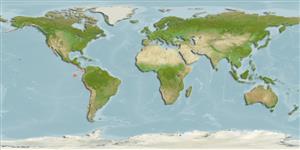Classification / Names
Noms communs | Synonymes | Catalog of Fishes(Genre, Espèce) | ITIS | CoL | WoRMS | Cloffa
>
Ophidiiformes (Cusk eels) >
Bythitidae (Livebearing brotulas)
Etymology: Diplacanthopoma: Greek, diploos = twice + Greek, akantha = thorn + Greek, poma = cover (Ref. 45335).
Eponymy: Dr David Starr Jordan (1851–1931) was a leading American ichthyologist, physician, educator, peace activist and believer in eugenics; moreover, he was founding President of Stanford University. [...] (Ref. 128868), visit book page.
More on author: Garman.
Environment: milieu / climate zone / profondeur / distribution range
Écologie
marin bathydémersal; profondeur 524 - 1050 m (Ref. 38374). Deep-water
Eastern Pacific.
Taille / Poids / Âge
Maturité: Lm ? range ? - ? cm
Max length : 44.7 cm TL mâle / non sexé; (Ref. 38374)
Description synthétique
Clés d'identification | Morphologie | Morphométrie
Épines dorsales (Total) : 0; Rayons mous dorsaux (Total) : 144 - 169; Épines anales: 0; Rayons mous anaux: 98 - 122. body tapers to a slender tail; imbricate scales present on body, absent from head and bases of dorsal and anal fins; opercular spine strong; a prominent skin flap ending in a large pore above the upper angle of the opercle; palatine teeth present; 3 or 4 well developed rakers on the first arch; branchiostegal rays 8; male intromittent organ on a broad fleshy pad or stalk; pectoral fins mounted on a broad lobe (Ref. 34024).
Body shape (shape guide): elongated; Cross section: compressed.
Rare species (Ref. 34024).
Life cycle and mating behavior
Maturité | Reproduction | Frai | Œufs | Fécondité | Larves
Nielsen, J.G., D.M. Cohen, D.F. Markle and C.R. Robins, 1999. Ophidiiform fishes of the world (Order Ophidiiformes). An annotated and illustrated catalogue of pearlfishes, cusk-eels, brotulas and other ophidiiform fishes known to date. FAO Fish. Synop. 125(18):178p. Rome: FAO. (Ref. 34024)
Statut dans la liste rouge de l'IUCN (Ref. 130435: Version 2025-1)
Menace pour l'homme
Harmless
Utilisations par l'homme
Pêcheries: sans intérêt
Outils
Articles particuliers
Télécharger en XML
Sources Internet
Estimates based on models
Preferred temperature (Réf.
123201): 5.8 - 7, mean 6.5 °C (based on 8 cells).
Phylogenetic diversity index (Réf.
82804): PD
50 = 0.5020 [Uniqueness, from 0.5 = low to 2.0 = high].
Bayesian length-weight: a=0.00447 (0.00172 - 0.01163), b=3.10 (2.87 - 3.33), in cm total length, based on LWR estimates for this (Sub)family-body shape (Ref.
93245).
Niveau trophique (Réf.
69278): 3.6 ±0.5 se; based on size and trophs of closest relatives
Résilience (Réf.
120179): Milieu, temps minimum de doublement de population : 1,4 à 4,4 années (Preliminary K or Fecundity.).
Fishing Vulnerability (Ref.
59153): Low to moderate vulnerability (35 of 100).
🛈
